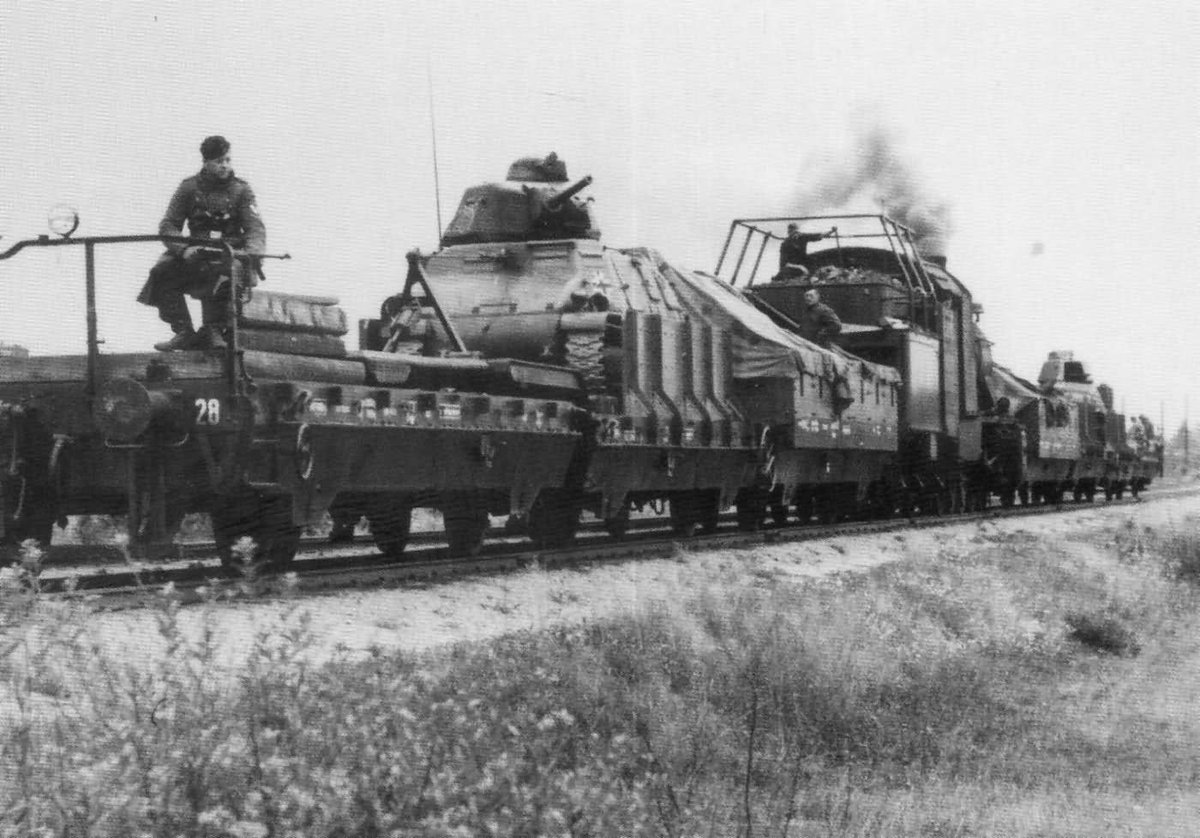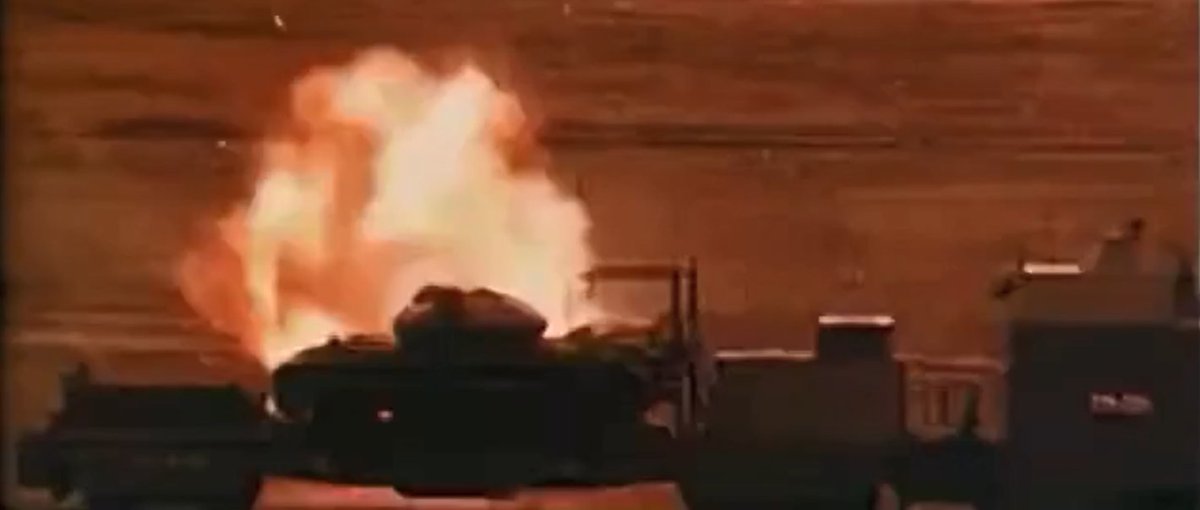(2/24) The T-84's story is a rather long and tortuous one that begins with the T-80UD (Object 478B) and the Pakistani order.
https://twitter.com/CalamineW/status/1672502587088596994
(3/24) The Pakistani order brought in much needed cash for the Malyshev factory, and one of the results was a new welded turret developed for the Pakistani T-80UDs (Object 478BE). This turret was made by the Azovstal and Azovmash factories in Mariupol.
https://t.co/utdgd8yz2Fbtvt.info/3attackdefense…


https://t.co/utdgd8yz2Fbtvt.info/3attackdefense…


(4/24) It's sometimes reported that these turrets use ceramic inserts, but after asking @AndreiBtvt, he confirmed that they only ever used polyurethane cellular filler blocks like the T-80U and T-80UD use.




(5/24) The Object 478 family underwent quite a few changes over the years. Object 478DU1 was the trial T-80UD developed for the Pakistani tender, which eventually entered production as Object 478BE.
https://twitter.com/dratka1/status/1399471091983208448?lang=zh-Hant
(6/24) Most of these were one-off prototypes, but the one that eventually entered service in 2000 was the 478DU9. 

(7/24) The 478DU9 actually originally entered service under the name BM Oplot, as referenced in the Cabinet of Ministers' resolution. But some time later, this was changed to T-84, and that name seems to have stuck.
https://t.co/Frclj6A9Lrcity.kharkiv.ua/uk/o-xarkove/p…


https://t.co/Frclj6A9Lrcity.kharkiv.ua/uk/o-xarkove/p…


(8/24) Anyway, what's so special about the T-84 compared to a T-80UD? Well, it can reverse at 32 km/h.
(9/24) The T-84 still uses BKP transmission units, which are also on even Soviet, Russian, and Ukrainian tank built since the T-64. So how does it get 32 km/h reverse speed out of these while the T-64/72 can do <5 km/h and the T-80 about 10 km/h? 

(10/24) A BKP is actually a combination of two things: a planetary gearbox (PKP) and final drive (BP). To alter the complex PKP is highly non-trivial, so KhKBM decided to modify the much simpler final drive instead. 

(11/24) As Chobitok explains, what they simply did was give the final drive another duplicated set of planetary gears. One set works in forward (reductor) movement, the other works in reverse. The reverse gear is limited to 4 speeds (32 km/h) for safety reasons.




(12/24) It is possible, in theory, to apply this modification to any tank using BKPs (T-64s, T-72s, T-80s, etc.), but so far only the T-84 and BM Oplot have it.
dzen.ru/a/YV7btA62cUBB…
dzen.ru/a/YV7btA62cUBB…
(13/24) Of course, the T-84 is no slouch going forwards either. Having a 1,200 hp engine helps a lot in that respect.
(13/24) The T-84 was also the first Ukrainian tank to feature network centric-warfare features like a satnav and datalinks. 

(14/24) Like the Bulat, it was originally supposed to have a gunner thermal sight (Buran-Catherine), but due to cost-cutting, it was instead stuck with the old Buran-E passive NV sight. 

(15/24) They would eventually get thermal sights around 2018. There is no confirmed model, but as with the Bulat, I would suspect it is Trimen's TPN-4 MBT. 

(16/24) They would also get 3rd gen NV for the commander, new L3Harris radios and SN-4215 Bazalt satnavs like other Ukrainian tanks getting modernised at the same time. 

(17/24) Accordingly, these modernised tanks have sometimes been called T-84U. However, I don't know if it's an official name. 

(18/24) The T-80UDs sold to Pakistan featured Kontakt-5. However, NII Stali, as the patent holder for Kontakt-5, demanded $55 million in licensing fees (about 10% of the Pakistani contract value). This was the impetus that led to the development of Nizh ERA.




(19/24) (The Ukrainian govt. would later annul NII Stali's patent in Ukraine, so today Ukraine makes its own Kontakt-5 4S22U and Kontakt-1 4S20U elements, but that's another story...)
https://t.co/cimDjY0s6Sold-defence--ua-com.translate.goog/index.php/stat…


https://t.co/cimDjY0s6Sold-defence--ua-com.translate.goog/index.php/stat…


(20/24) The T-84 would be the first Ukrainian tank to use Nizh. I don't know how effective it is on the T-84, since it was never deployed in the Donbas War and there is not enough info from the ongoing invasion. It seems to work, based on this video.
(21/24) There are only 6 T-84s in Ukraine at this time. One ('Murchyk') is with the 3rd Tank Brigade. The other 5 are most likely with the 14th Mechanised Brigade.
(22/24) 14 Mech. received theirs for the 2018 NATO SETC, where they encountered serious problems with the autoloader, fire control system, as well as other systems. I'd hope they've fixed them by now.
novynarnia-com.translate.goog/2018/06/15/a-y…
novynarnia-com.translate.goog/2018/06/15/a-y…
(23/24) The other country with T-84s is...the US, who bought four 'T-80UDs' in 2004, mostly for testing. I don't know if the US has any plans to send them back to help the Ukrainians.
https://twitter.com/DRatka1/status/1243942381864525824/photo/1
(24/24) Overall, I think the T-84's an interesting vehicle. There almost certainly aren't enough of them to make a real difference in the war, but the crews lucky enough to drive them seem to appreciate it.
@hulldwnposition To be honest, I'm not even that sure BE1 is a real designation, would have to ask @AndreiBtvt
@TimEdin_1974 As to your original statement, yes, Thailand bought Oplot-Ts (478DU9-T), which are pretty different from what the Ukrainians call 'T-84' (478DU9).
The US bought 4 of the original 10 'T-84' production batch from 2000. The remaining 6 are in Ukraine.


The US bought 4 of the original 10 'T-84' production batch from 2000. The remaining 6 are in Ukraine.


@TimEdin_1974 The ones the US bought were given Drozd for testing as well.
mil.in.ua/en/news/ukrain…
mil.in.ua/en/news/ukrain…
@TimEdin_1974 This thread was talking strictly about 478DU9. That's why I didn't mention the 478DU9-T (Oplot-T) or 478DU9-1 (BM Oplot).
@TimEdin_1974 I never once said in this entire thread that BM Oplot and Oplot-M are not the same tank. I said 'T-84' (by which I mean what the Ukrainians actually call a T-84, 478DU9) and BM Oplot (Oplot-M, 478DU9-1) from 2009 are not the same tank. 

@TimEdin_1974 You brought up Oplot-Ts, which yes, Thailand does use. In this thread I was only talking about T-84 (478DU9), Thai Oplot-Ts are based on BM Oplot/Oplot-M (478DU9-1), so I did not talk about them here, whereas the Americans do actually have T-84s (478DU9).
@TimEdin_1974 That's why I mentioned the Americans and not the Thais. Maybe that's where the misunderstanding came from.
@TimEdin_1974 And by the way, if I wanted clicks, there are way easier ways to get them than spending 20+ years researching Ukrainian, Soviet, and Russian tanks and then talking about them on a dying social media platform. I just do this because I like talking and discussing these things.
@TimEdin_1974 I apologise if I created any misunderstanding on my part. It was not my intention.
• • •
Missing some Tweet in this thread? You can try to
force a refresh
















































